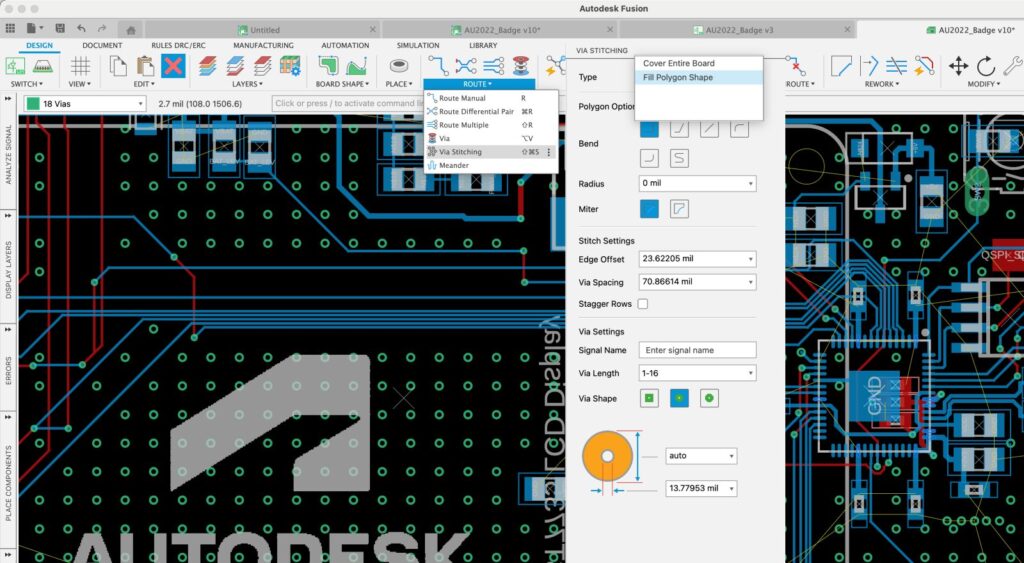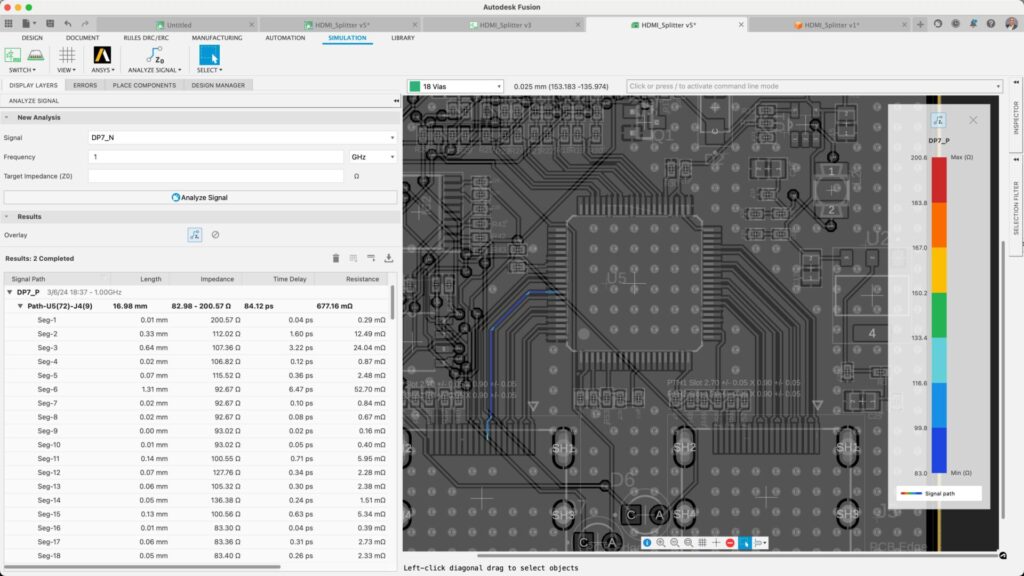Elevate your design and manufacturing processes with Autodesk Fusion

PCB design is a multifaceted field driven by innovative methods and cutting-edge technologies. One such method, a cornerstone of effective PCB design, is Via Stitching. This technique has revolutionized how PCB designers approach ground planes and manage ground loops, thus having a crucial role in improving the integrity and performance of PCB designs. In this comprehensive guide, we delve deep into the intricacies of Via Stitching, its significance, types, application, and the benefits it brings to your PCB designs.
Why do we need Via Stitching?
Before we delve into the details of Via Stitching, let’s first understand what a Via is. During the production stage of a PCB, a hole is drilled through its base material to create a Via. This hole is then filled with copper on the inner layer, enabling it to transmit copper traces across multiple layers of the PCB.
However, Via Stitching uses multiple Vias to drill and connect copper areas on different layers of the PCB. Typically, designers apply this technique to larger copper planes, such as Ground filling planes and Power planes, etc. This application enhances the ground return paths in the PCB from load devices to the power source.
Why is stitching that important?
The significance of Via Stitching in PCB design cannot be overstated. Maintaining a low impedance and short return loops is a practical solution. Via Stitching establishes a robust vertical connection through the board structure by tying together larger copper areas on different layers. This decreases the resistance in the ground plane, reducing heat dissipation and maintaining the balance of copper resistance across all places in the PCB.
Moreover, Via Stitching plays a pivotal role in high-frequency operations. It shields RF or Mixed-signal circuits from EMI interference, making it an invaluable tool in WiFi, Bluetooth, and other wide bands of high-frequency elements.
Different Types of Via Stitching
Via Stitching is not a one-size-fits-all process. It caters to different requirements and scenarios, resulting in distinct types of via-stitching processes. The three main types are:
Constant Ground Via Stitching
Designers most commonly use Constant Ground Via Stitching in Via Stitching techniques. It ensures shorter ground return paths in PCB from the load devices to the power source, maintaining a healthy ground return path and obtaining low resistance in the ground plane.
Thermal Via Stitching
Thermal Via Stitching is used to increase power heatsinking on the board. When you have a lot of Vias in a big ground plane right next to a high current power trace, the increased surface area soaks up the heat better and allows it to run cooler.
Shielding Via Stitching
Shielding Via Stitching, a PCB picket fence is done for EMI-related reasons on high-frequency RF or Mixed-signal circuits. It is created using single or multiple rows of Vias stitched across the perimeter of a large copper plane that is too close to high-frequency tracks.
Implementing via stitching in PCB design with Autodesk Fusion

Implementing Via Stitching in PCB design requires careful planning and precision. Stitching Vias involves locating and placing an extensive array of Vias around a board, with precise spacing. Most CAD tools, such as Fusion, offer utilities in their PCB Editor to place stitching Vias with user-defined size and spacing, enabling designers to place stitching Vias by selecting a Via template or setting a custom Via size and layer transition.
The Impact of Via Stitching on Via Impedance

Via Stitching and antipads work together to set the impedance of a Via, both for single-ended signals and differential signals passing through Vias. Modifying the capacitance and inductance by the presence of a grounded stitching Via near the signal Via should be enough to suppress noise, particularly for slow GPIOs, I2C, UART, or other slow digital protocols.
Using Via Stitching in Shielding
When you place Via Stitching in an array, it can block electromagnetic waves up to certain frequencies, creating what many call ‘shielding.’ You should set the Via spacing for shielding at approximately 1/10th of the wavelength of the highest frequency you need to shield from interfacing.
Via Stitching for Power
In a PCB layout for a power system, closely spaced Vias can provide high current with minimal temperature rise between layers. This would allow a Via to transfer large amounts of current with low loss between layers.
Automation of Via Stitching Placement
Since the placement of stitching Vias involves locating and placing an extensive array of Vias around a board with precise spacing, automating this process can be a significant time-saver. Tools like Altium Designer include a simple utility in the PCB Editor to place stitching Vias with user-defined size and spacing.
The Role of Via Stitching in Heat Dissipation

Via Stitching also plays a critical role in heat dissipation. When used near or under surface mount power components, Via Stitching spreads the heat to another, perhaps more significant, ground plane on the other side of the PCB, effectively reducing the overall junction temperature of the targeted high-power component.
Via Stitching in Multi-Layer PCBs
In a multi-layer PCB, it’s common to have more than one region of copper assigned to the same ground net. Stitching Vias is a valuable tool for connecting these everywhere and ensuring the minimum possible impedance for any return current propagating along the reference plane in the PCB.
The Impact of Via Stitching on Noise Reduction
The presence of a grounded stitching Via near the signal Via reduces noise in two ways. Firstly, the loop inductance in the Via region is lower because of being closer to the ground. Secondly, this proximity to the ground makes the signal Via/ground Via transition dominate the total capacitance experienced along the Via.
The Future of Via Stitching
The future of Via Stitching looks promising, with new advancements and applications on the horizon. As PCB requirements grow for higher efficiency and compactness, the role of Via Stitching becomes more critical. As we push the boundaries of PCB design further, we can’t overstate the importance of mastering and applying Via Stitching in your designs.
In the grand scheme of PCB design, Via Stitching is just one of the many techniques available to designers. Yet, its impact is profound. Via Stitching provides significant benefits, such as improving ground return paths, managing ground loops, enhancing heat dissipation, and reducing noise. These advantages can significantly enhance your PCB designs’ integrity and performance. By mastering and applying this technique, you can elevate your PCB designs, ensuring they perform optimally and reliably for their intended functions.